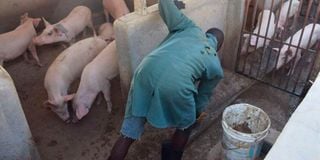Premium
How poor hygiene leads to slow growth of pigs

Brian Makokha, a worker at Boresha Farm in Kakamega County, attends to pigs. The farm has 400 animals.
What you need to know:
- Smelly pig farms indicate poor disposal of waste, poor hygiene and cleanliness.
- This is a recipe of many diseases and pests that lead to retardation of the animals.
Mike’s farm in Ruiru hosts some 800 pigs and he has always had a good manager since he started farming six years ago. Three weeks ago, he asked me to visit the farm. He had noticed that his pigs were taking too long to attain the baconer weight.
Upon arrival on the farm, I noticed something was amiss. There was higher concentration of piggy smell in the air. On my last visit about seven months earlier, I could hardly pick the smell. Smelly pig farms indicate poor disposal of waste, poor hygiene and cleanliness.
I was received by Wekesa, the farm manager. He told me he had only been on the farm for two months. I noticed many of the farm workers were new. I called Mike and he confirmed that he had had a heavy turnover of staff, including managers, since my last visit.
His explanation was a red flag. Sudden loss of staff on a livestock farm can offset established management systems and result in poor performance. New workers on a farm always have a one to two months learning curve to understand how the farm is managed.
Wekesa informed me the pigs were taking too long to mature. They would go up to eight months. Piglet deaths were about 6 per cent compared to the expected below 2 per cent. During my last visit, the piglet mortality had consistently been 1 to 2 per cent from birth to baconer maturity. Pigs also matured at about six months.
I noticed, from the farm records, problems had started with the exit of the farm manager I had left on the farm. He had worked there for six continuous years. There had been two other managers before Wekesa, who had left soon after being recruited. I also noticed four of the most experienced staff had left within the problematic period.
Death of piglets
The main cause of death of the piglets was recorded as diarrhoea, pneumonia and weight loss. It was said the piglets would get thin over some time and then die either after weaning or while still suckling. There was no specific diagnosis for the cause of diarrhoea or pneumonia.
Next, I carried out observation in all the production units and examined sick animals. I did not find it necessary to take samples for laboratory examination.
I observed the finisher pigs were maturing at seven months. That was already above the recommended six months. Any time between 5.5 and 6.5 months is acceptable.
However, it is good to note that every day the pig spends on the farm after attaining six months of age is a deduction on the farmer’s profit. Beyond seven months, the farmer starts making a loss. The pigs were healthy but the pens were dirty. They appeared to have been washed two days before. There were feed remains in the troughs meaning the pigs were being given more than they needed.
Wekesa explained they were giving a lot of feed to enhance weight gain. I informed him that was not necessary as it was wasteful and a loss to the farmer. You see, when pigs are fed more than they need, a lot of feed is wasted as faeces. Again, the animals will lay down excess fat and downgrade the meat quality, further eating into the farmer’s profit.
Cleaning and disinfection
The grower pig pens had the same hygiene issues as the finisher pens. Urine had also stagnated in some of the pens, explaining the piggy smell I had picked in the air. When the urine stagnates, bacteria breaks it down and generates the piggy smell which wafts into the air.
Most of the grower pigs were below their expected weights. I also noticed that some were sneezing or had occasional coughs. That was an indication of the long-standing or chronic respiratory infections. The most common cause of such infection is a bacterium called mycoplasma. I treated the sick pigs with the recommended antibiotic by intramuscular injection that I would give for three days.
The nursing piglets had most problems. Some were coughing and most had whitish or yellowish diarrhoea. Most of them were thin and their body weights were lower than their age. The pens were also unhygienic. I recommended cleaning and disinfection of the pens.
I treated the piglets with antibiotic and multivitamin injection. I also gave antibiotics by mouth and instructed Wekesa how he would repeat the oral treatment for another four days. The prolonged diarrhoea due to unhygienic conditions was the major cause of the stunting of the pigs.
Finally, I visited the weaner piglets’ pens. The main problem there was diarrhoea and poor hygiene, just like with the nursing piglets. In addition, the piglets had skin infestation with mites. They spent a lot of time scratching against the wall. Mites, when they affect pigs for prolonged periods, result in stunting and poor weight gains.
I gave an injection against mites to all the affected pigs and also recommended weekly washing with cypermethrin, a synthetic pyrethrin chemical. By the time of publishing this article, Mike confirmed his pigs were recovering well.





